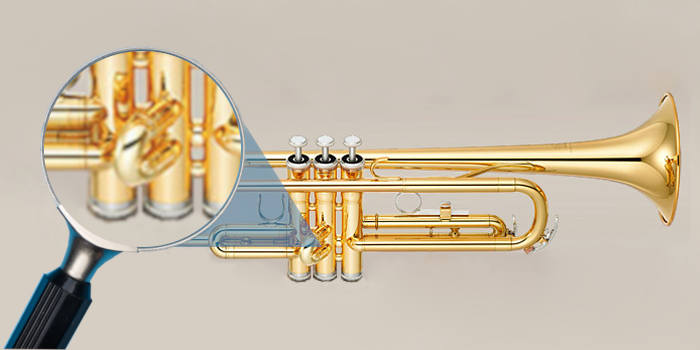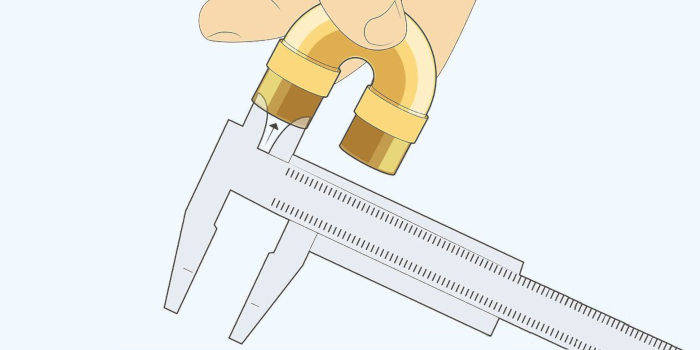
Whether you’re an experienced trumpet player or you’re just starting out, you might have wondered what effect trumpet bore size really makes on sound and performance.
If different models have different bore sizes, there must be a reason, right?
I’d love to give you straightforward advice like smaller bore trumpets are better for “X” and larger bore trumpets are better for “Y”. But the truth isn’t that simple.
Here I’ll explain how to measure bore size on a trumpet and then discuss the main theories circulating about trumpet bore size effect.
How to measure bore size on a trumpet?
Most Bb trumpets have a bore size typically ranging from 0.422 to 0.485 inches.
Bore size is usually measured at the inside diameter of the second valve slide, the small piece of tubing extending off the side of the second valve casing, called the second valve slide (related: Parts of a Trumpet Explained).
Measuring the bore size on a trumpet, or any other brass instrument, is easy. You just need a caliper that’s accurate within 0.001 inches or 0.01 millimeters. Here’s how to measure:
- Gently remove the second valve slide
- Insert the upper jaws of the caliper into one end of the slide
- Widen the caliper until both jaws touch the inside of the slide tubing and can’t widen any further
- Check the caliper reading—this is your bore size

You can also use an inside micrometer. But micrometers tend to run much more expensive than calipers.
Some sources you might find online will have you fit the second valve slide over a tapered mandrel and then measure the width of the mandrel at the widest point where the slide won’t go any further.
Although this will certainly work, I don’t recommend this method only because, if you’re like most people, you probably don’t have an assortment of tapered mandrels on hand to use. Mandrels are long metal rods that are more commonly found in brass repair shops.
Does bore size really make a difference?
Bore size is a contentious issue among trumpet players. Some are convinced switching between bore sizes can make a big difference in play. Others attribute such differences to other factors.
Let’s talk about the two commonly held theories and the arguments for each.
Theory 1: Trumpet bore size affects resistance and intonation
Some trumpet players argue that, all others things being equal, a larger bore size lends to less air resistance and better lip, or aperture, control. These musicians feel this can lead to subtle changes in sound intensity.

…when I want to sound ‘broad’ and have a ‘fat’ sound, I find that the sound propagates better on a large bore horn and seems less stuffy. Small bore horns sound more ‘compact’ and limited. I like my sound much better and can hear myself vocalize better on a large bore horn than a small bore horn.
JWG, Trumpet Herald
Some players claim the lowered resistance of larger bores gives them a wider range—as much as three semitones higher than with a smaller bore.
And then there are some trumpeters that go a step further, suggesting that with the wider range comes more difficulty staying in tune. They argue that smaller bores are more “forgiving” in this way and easier to handle.
Yamaha contends that the instrument’s sound is affected, writing that small bore trumpets require “less breath”, resulting in a trumpet that’s easier to play and has a mellower timbre.
Other musicians have disputed any discernible difference in resistance at all, arguing that a player may feel less resistance on a large bore trumpet. But the actual change in air flow resistance is too small to affect sound or tonal range.

I’m not saying bore has no overall effect on the playability of the instrument…it does alter the spectrum of sound and overtone series amplitude levels, etc. However, it usually has nothing to do with the feel of resistance most find necessary to play in the upper stratosphere!
Jason Harrelson, Harrelson Trumpets
Instead, some professionals maintain, leadpipe and bell tapers are the primary drivers of any perceived resistance.
Theory 2: The difference from bore size alone is negligible
The other prevailing theory behind trumpet bore size is that its importance is overstated. Many trumpet players argue that other features, such as shape and size of the leadpipe, mouthpiece and bell, have a much greater impact on sound and air flow than bore size.

Bore size certainly is just one part of the equation along with the leadpipe taper, venturi size, bell flair and so on…I agree that two basically identical horns with two different bores will play differently, but as we all know, two supposedly identical horns seldom [if ever] play the same.
Tony Scodwell, Scodwell USA
These musicians maintain that bore size plays a small part in determining how an instrument performs. And they recommend individual trumpet players try out different models to find the right balance for their own playing style.

My experience has led me to believe that the best playing instruments are balanced within themselves. Large bells with medium leadpipes or large leadpipes with medium-large bells. This balance usually creates the optimum airflow you are looking for. Where does bore fit into all of this? Basically, it puts it last on the priority list. Balance is what you are looking for.
Andrew Naumann, Naumann Trumpets
In my view, you only have to talk with different trumpet players to know that no two players will experience the same instrument exactly the same way. They won’t sound the same, and they won’t feel the same playability and feedback.
Given the more obvious effects we know different mouthpieces and bells can have on this front, it seems much harder to attribute particular playing characteristics to a trumpet’s bore size.
Conclusion
My two cents on trumpet bore sizes is that I wouldn’t put too much stock in them. The most widely held view for now seems to be that bore size doesn’t make much difference on the instrument as a whole.
There are just too many factors—from different parts of the instrument to a player’s own skill and anatomy—that affect resistance, tonality and other characters of performance. So comparing two models by bore size just isn’t all that meaningful.
Do you think a bore size difference of .458 and .460 would be discernable to the average professional? Does a smaller bore necessarily create better slots on the horn, or are there too many other factors to consider, e.g., bell size, lead pipe, etc.?
Hi Steven,
Thanks for your message. A difference in bore size of .002 is very slight. And I doubt that a trumpet player at any level of experience would notice–all other things being equal. Though opinions vary slightly on the impact of bore size and the difference it can make in play, there is a general consensus that it’s just one of several factors that should be considered. So I would say that, no, smaller bore size does not necessarily create better slots on the horn.
I found this article to be very informative. Thanks!